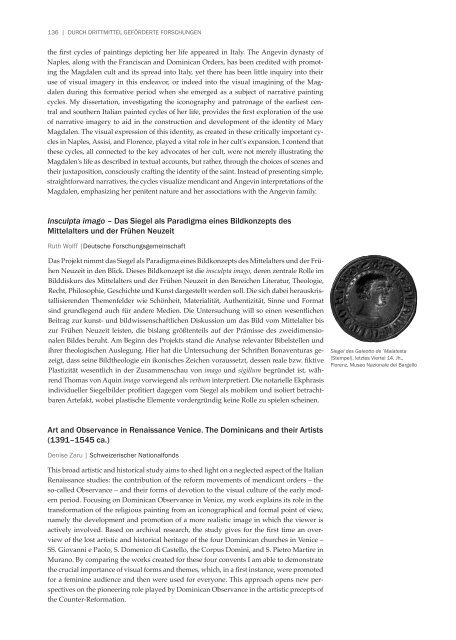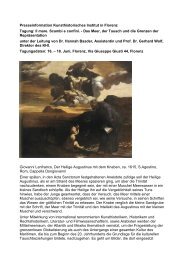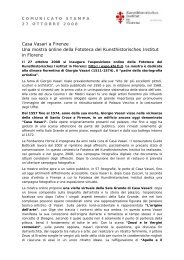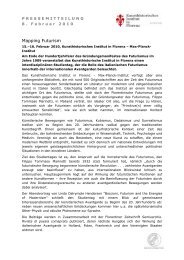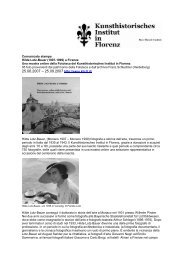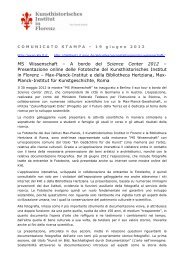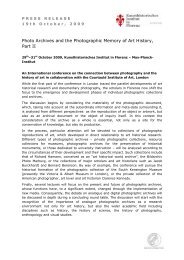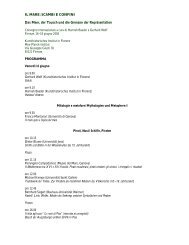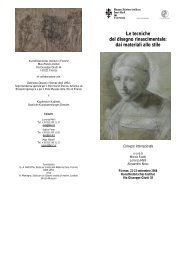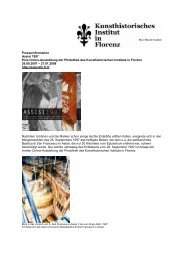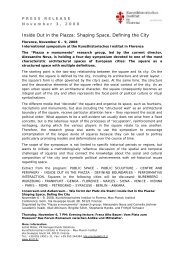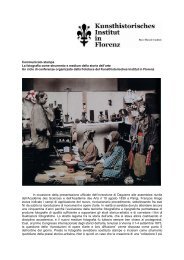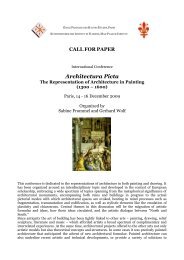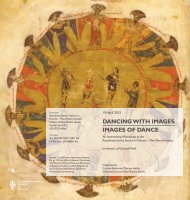forschungsbericht november 2008 – juli 2012 - Kunsthistorisches ...
forschungsbericht november 2008 – juli 2012 - Kunsthistorisches ...
forschungsbericht november 2008 – juli 2012 - Kunsthistorisches ...
Erfolgreiche ePaper selbst erstellen
Machen Sie aus Ihren PDF Publikationen ein blätterbares Flipbook mit unserer einzigartigen Google optimierten e-Paper Software.
136 | DURCH DRITTMITTEL GEFÖRDERTE FORSCHUNGEN<br />
the first cycles of paintings depicting her life appeared in Italy. The Angevin dynasty of<br />
Naples, along with the Franciscan and Dominican Orders, has been credited with promoting<br />
the Magdalen cult and its spread into Italy, yet there has been little inquiry into their<br />
use of visual imagery in this endeavor, or indeed into the visual imagining of the Magdalen<br />
during this formative period when she emerged as a subject of narrative painting<br />
cycles. My dissertation, investigating the iconography and patronage of the earliest central<br />
and southern Italian painted cycles of her life, provides the first exploration of the use<br />
of narrative imagery to aid in the construction and development of the identity of Mary<br />
Magdalen. The visual expression of this identity, as created in these critically important cycles<br />
in Naples, Assisi, and Florence, played a vital role in her cult's expansion. I contend that<br />
these cycles, all connected to the key advocates of her cult, were not merely illustrating the<br />
Magdalen's life as described in textual accounts, but rather, through the choices of scenes and<br />
their juxtaposition, consciously crafting the identity of the saint. Instead of presenting simple,<br />
straightforward narratives, the cycles visualize mendicant and Angevin interpretations of the<br />
Magdalen, emphasizing her penitent nature and her associations with the Angevin family.<br />
Insculpta imago <strong>–</strong> Das Siegel als Paradigma eines Bildkonzepts des<br />
Mittelalters und der Frühen Neuzeit<br />
Ruth Wolff |Deutsche Forschungsgemeinschaft<br />
Das Projekt nimmt das Siegel als Paradigma eines Bildkonzepts des Mittelalters und der Frühen<br />
Neuzeit in den Blick. Dieses Bildkonzept ist die insculpta imago, deren zentrale Rolle im<br />
Bilddiskurs des Mittelalters und der Frühen Neuzeit in den Bereichen Literatur, Theologie,<br />
Recht, Philosophie, Geschichte und Kunst dargestellt werden soll. Die sich dabei herauskristallisierenden<br />
Themenfelder wie Schönheit, Materialität, Authentizität, Sinne und Format<br />
sind grundlegend auch für andere Medien. Die Untersuchung will so einen wesentlichen<br />
Beitrag zur kunst- und bildwissenschaftlichen Diskussion um das Bild vom Mittelalter bis<br />
zur Frühen Neuzeit leisten, die bislang größtenteils auf der Prämisse des zweidimensionalen<br />
Bildes beruht. Am Beginn des Projekts stand die Analyse relevanter Bibelstellen und<br />
ihrer theologischen Auslegung. Hier hat die Untersuchung der Schriften Bonaventuras gezeigt,<br />
dass seine Bildtheologie ein ikonisches Zeichen voraussetzt, dessen reale bzw. fiktive<br />
Plastizität wesentlich in der Zusammenschau von imago und sigillum begründet ist, während<br />
Thomas von Aquin imago vorwiegend als verbum interpretiert. Die notarielle Ekphrasis<br />
individueller Siegelbilder profitiert dagegen vom Siegel als mobilem und isoliert betrachtbaren<br />
Artefakt, wobei plastische Elemente vordergründig keine Rolle zu spielen scheinen.<br />
Siegel des Galeotto de´Malatesta<br />
(Stempel), letztes Viertel 14. Jh.,<br />
Florenz, Museo Nazionale del Bargello<br />
Art and Observance in Renaissance Venice. The Dominicans and their Artists<br />
(1391<strong>–</strong>1545 ca.)<br />
Denise Zaru | Schweizerischer Nationalfonds<br />
This broad artistic and historical study aims to shed light on a neglected aspect of the Italian<br />
Renaissance studies: the contribution of the reform movements of mendicant orders <strong>–</strong> the<br />
so-called Observance <strong>–</strong> and their forms of devotion to the visual culture of the early modern<br />
period. Focusing on Dominican Observance in Venice, my work explains its role in the<br />
transformation of the religious painting from an iconographical and formal point of view,<br />
namely the development and promotion of a more realistic image in which the viewer is<br />
actively involved. Based on archival research, the study gives for the first time an overview<br />
of the lost artistic and historical heritage of the four Dominican churches in Venice <strong>–</strong><br />
SS. Giovanni e Paolo, S. Domenico di Castello, the Corpus Domini, and S. Pietro Martire in<br />
Murano. By comparing the works created for these four convents I am able to demonstrate<br />
the crucial importance of visual forms and themes, which, in a first instance, were promoted<br />
for a feminine audience and then were used for everyone. This approach opens new perspectives<br />
on the pioneering role played by Dominican Observance in the artistic precepts of<br />
the Counter-Reformation.


